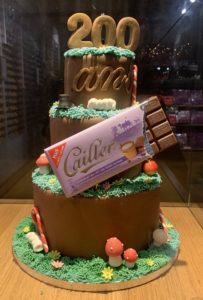
After a long week of mercury negotiations and international issues, it was only fitting to close our trip by learning about one of Switzerland’s finest exports: chocolate. In order to do this, we toured Maison Cailler, a chocolate factory home to Switzerland’s oldest chocolate brand that still exists, celebrating its 200th anniversary this year.
As soon as we arrive, we are greeted by a gorgeous mountain view and an aroma of chocolate wafting through the air. So, it was already off to a good start.
Before the tour starts, we are handed electronic chocolate bars that speak and told they will interpret things on the wall for us. This was strange and new but did nothing to prepare us for what we were about to see. As we begin the tour, it feels as though we are entering a crossover between Disney World and Willy Wonka, wi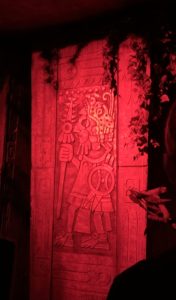 th a historical narrative. We are ushered into a room by ourselves and the doors slide shut behind us. Then, the floor begins to sink, and another room is slowly revealed. It is decked out as a tropical Aztec island, and a narration begins, describing the Aztec god of cacao who shared a magical chocolate drink with man, and was far too powerful for women. The narration continues through many different rooms, telling the history of chocolate through animatronic scenes with just the right amount of education and humor. Some of these rooms included a medieval dining area with portraits that talked, mountainous range with busts of significant chocolatiers, and an inside look at the first Cailler factory. In all honesty, much of the narration has blurred together since there was so much stimulation from each room and I wanted to take it all in.
th a historical narrative. We are ushered into a room by ourselves and the doors slide shut behind us. Then, the floor begins to sink, and another room is slowly revealed. It is decked out as a tropical Aztec island, and a narration begins, describing the Aztec god of cacao who shared a magical chocolate drink with man, and was far too powerful for women. The narration continues through many different rooms, telling the history of chocolate through animatronic scenes with just the right amount of education and humor. Some of these rooms included a medieval dining area with portraits that talked, mountainous range with busts of significant chocolatiers, and an inside look at the first Cailler factory. In all honesty, much of the narration has blurred together since there was so much stimulation from each room and I wanted to take it all in.
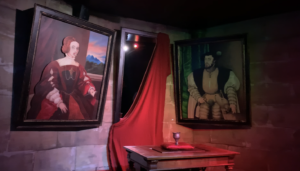
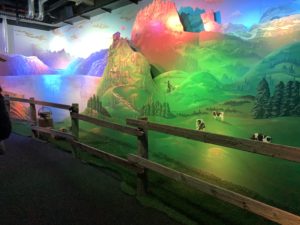
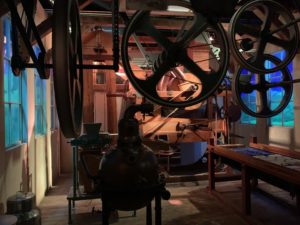
Francois-Louis Cailler is credited as the founder of Cailler, however the brand went through lots of partnerships, management changes, and even bankruptcy before it reached its worldwide fame. In the early 1900s, Nestle had milk chocolate production done by Peter and Kohler, which later merge with Cailler to manufacture higher-quality chocolate and reach international audiences. Finally, the company is relaunched officially as Cailler of Switzerland in 2006.
The final room opened into a large area with a wall mural and tables with ingredients on them. The mural featured many different people and what they contribute to the chocolate making process. We were able to use the electronic chocolate bar to hear all the different stories of how cocoa is farmed from an actual farmer or how milk is gotten, told by a surprisingly well-spoken cow. In the center of the room were tables with some of the main ingredients involved in making chocolate, such as cocoa beans, available to discover using different senses, such as sight, touch, smell, and even taste. Unfortunately, the ingredients are much less tasty than the final product.
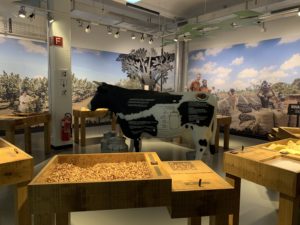
After reading and listening to how the ingredients are found, we move on to see the chocolate in use. On one side of the new area is a long machine producing a treat called Mini-Branches. At first, I thought this machine was just an example but as I kept watching, I realized it was making chocolates in real time. According to the audio, this machine is a smaller version of other ones they use even though it produces 90 Mini-Branches per minute. It shows the whole process of turning chocolate into long ropes, cutting a length of rope, covering it in melted chocolate, and then packaging it. At the end of the conveyor, there were even samples set out for us to try.
On the other side of the room was a woman working on intrica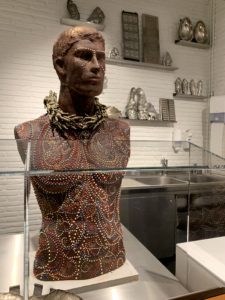 te chocolate designs in molds. I felt a little bad for her because of all the people standing around watching and taking pictures. But not bad enough to not participate in taking pictures too. It was very interesting to see the amount of precision she had in piping out small hearts and other ornamental details. Next to her were other finished chocolate artworks including a phenomenal, life-sized bust of a man with even more ornamentation. After seeing this, I fully believe chocolatiers are artists and they practice in a beautiful art form, one of which I may feel inspired to take up, although I would probably eat all my materials.
te chocolate designs in molds. I felt a little bad for her because of all the people standing around watching and taking pictures. But not bad enough to not participate in taking pictures too. It was very interesting to see the amount of precision she had in piping out small hearts and other ornamental details. Next to her were other finished chocolate artworks including a phenomenal, life-sized bust of a man with even more ornamentation. After seeing this, I fully believe chocolatiers are artists and they practice in a beautiful art form, one of which I may feel inspired to take up, although I would probably eat all my materials.
Continuing in the tour, we are guided by the electronic chocolate bar once more in a sensual chocolate walk. We are given a piece of chocolate and instructed to unwrap, look, feel, listen, smell, and then finally eat it to fully understand and reflect on the processes we just learned about. Each step leading up to eating it felt painfully long, but it was certainly a new and interesting challenge to try and appreciate the chocolate before eating it by the handful.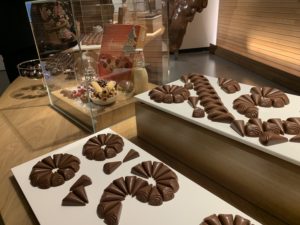
Luckily, any need for more chocolate after analyzing it was fully satisfied as we went through the tasting room. The displays of chocolate and holiday cheer were not only wonderful to look at but were delicious as well because we could sample as much as we wanted. They offered about 10 different types of chocolates to try, which were surprisingly filling because of how rich the chocolate was and how they did not provide cups of water for us, probably to prevent hungry college students from eating their entire collection. Needless to say, this was a pretty good conclusion to an overall excellent tour.
After Maison Cailler, we were able to tour La Maison du Gruyere, a cheese-making facility, which also offered samples but unfortunately not an endless supply. We also ate lunch there and then concluded the day with a visit to a very scenic town featuring mountains and a castle. It was sad that that was essentially our final day in Switzerland, but it was certainly a very good finale to a wonderful and exciting trip.